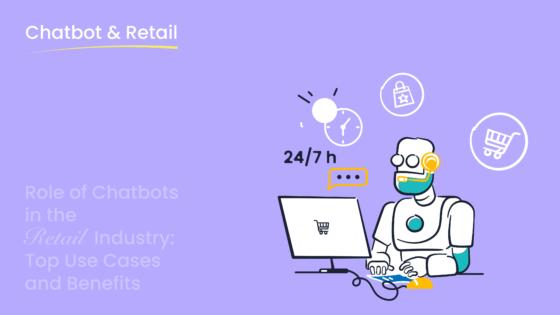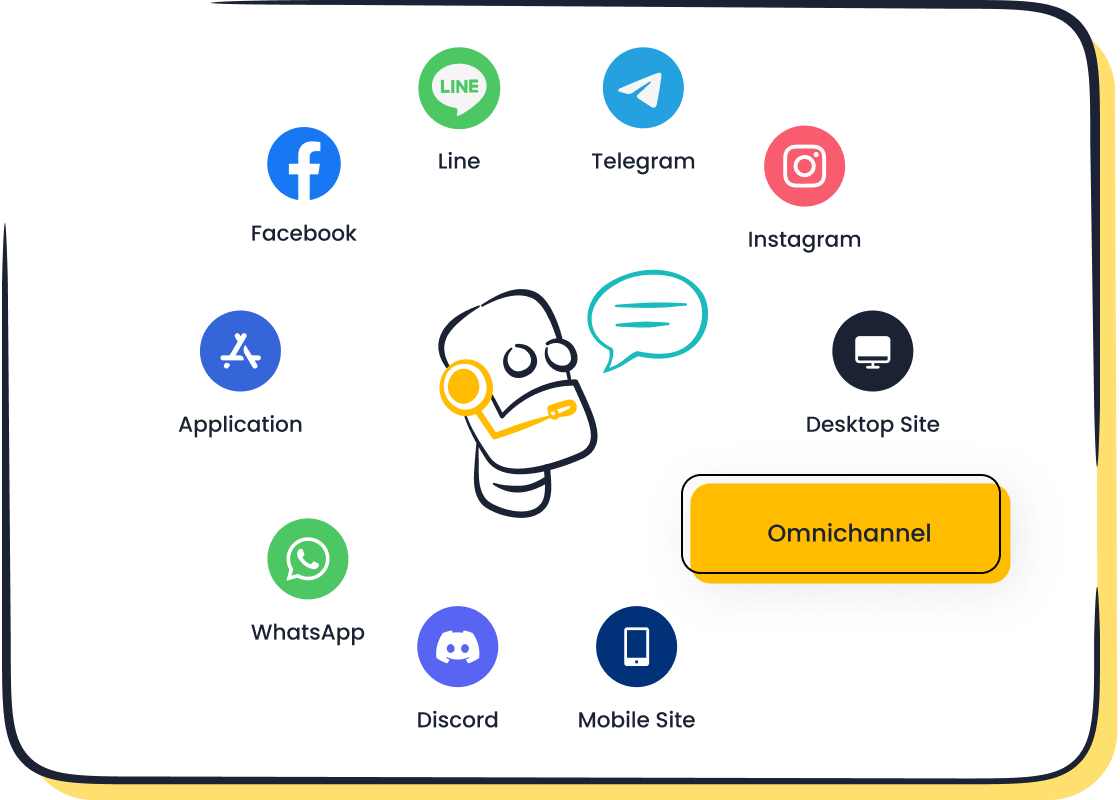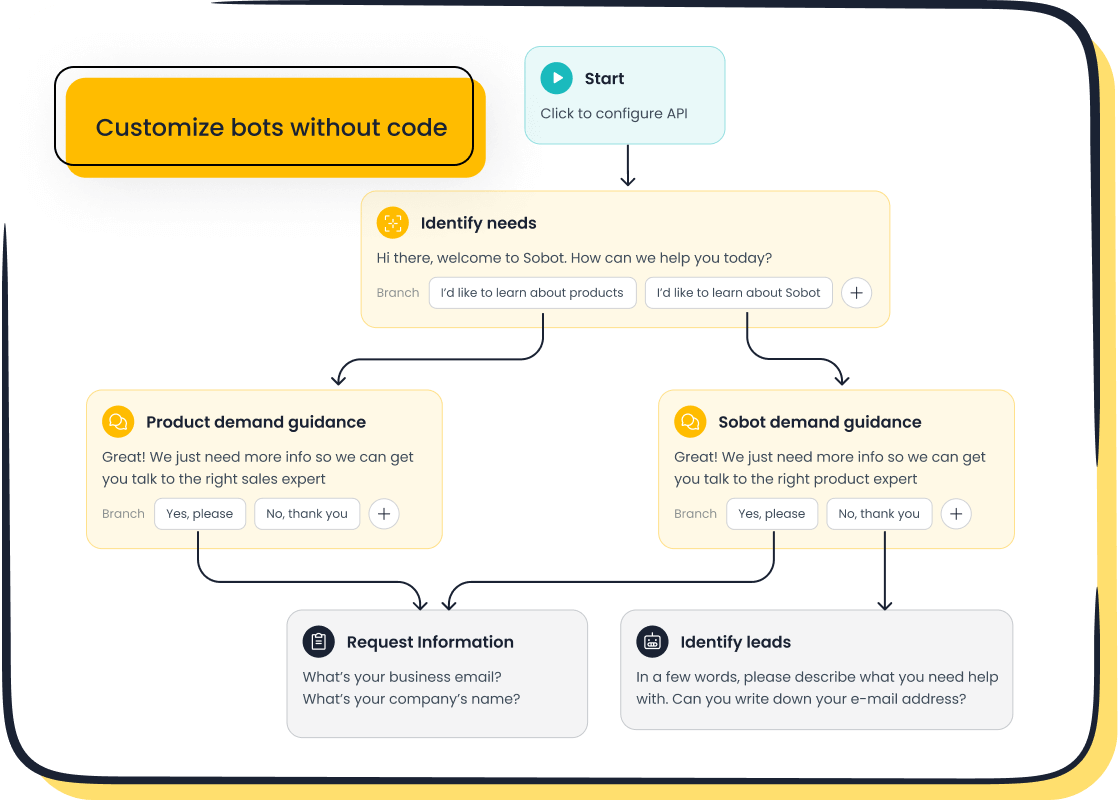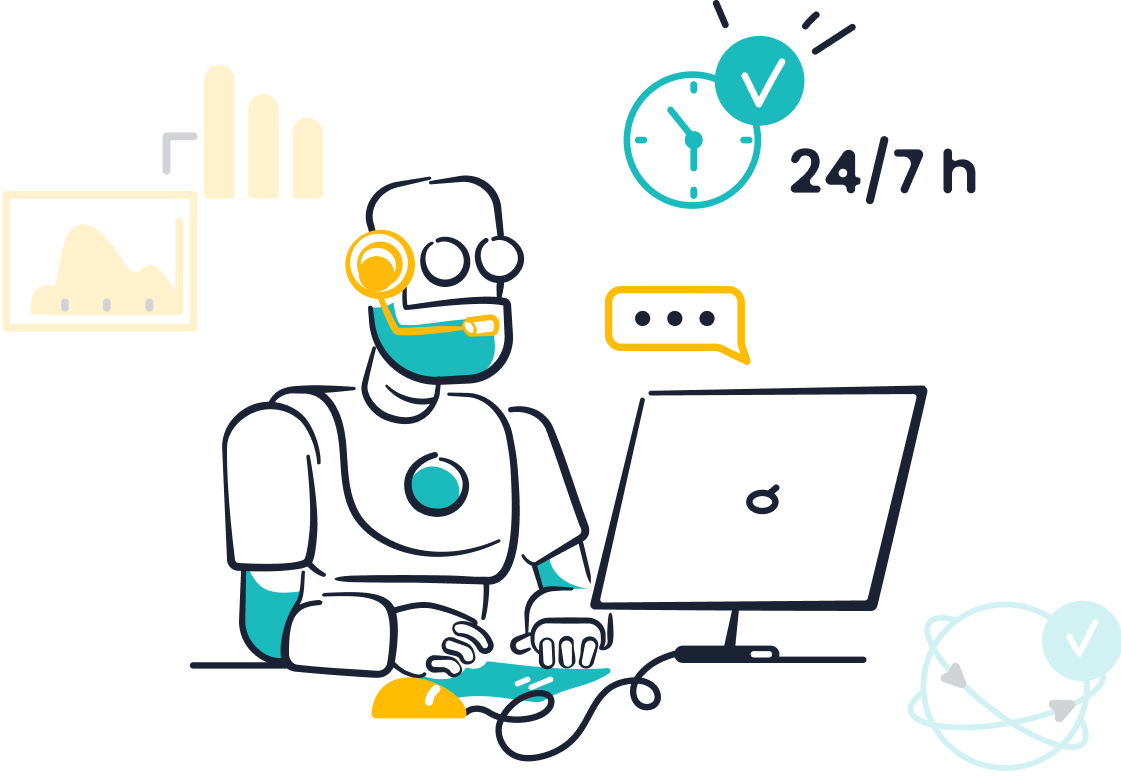Step-by-Step Guide to Creating an Ecommerce AI Chatbot

Building an ecommerce ai chatbot is easier than you might think. Many e-commerce businesses now use ai chatbots to improve customer support, boost sales, and cut costs. For example, 67% of retailers have seen sales increase after adding ai chatbots, and 72% use ai to reduce expenses. With Sobot AI, you can follow a step-by-step guide and launch your own chatbot without any coding. The platform offers drag-and-drop tools, pre-built templates, and expert support, making it simple for anyone to enhance customer service and customer support.
| Metric Description | Percentage / Impact |
|---|---|
| Retailers using conversational AI for customer service | 42% |
| Sales increase due to retail chatbots | 67% |
| Retailers using AI to reduce costs | 72% |
Set Chatbot Goals
Define Objectives
Before you start chatbot creation, you need to set clear goals. Think about what you want your ai chatbot to achieve for your ecommerce business. Do you want to answer customer questions faster? Do you want to boost sales or reduce support costs? Setting objectives helps guide your chatbot development and makes it easier to measure success.
Tip: Write down your main goals. For example, you might want your chatbot to handle 80% of customer questions without human help or increase your online sales by 20%.
Many businesses use Sobot’s ai chatbot to improve customer satisfaction and save time. Sobot’s platform lets you build your own ai chatbot with no coding. You can focus on your goals while the system handles the technical side. This approach makes chatbot creation simple and effective.
Identify Use Cases
After you set your objectives, you should decide how your chatbot will help your customers. The best way to do this is to look at common tasks in ecommerce where an ai chatbot can make a difference. Here are some top use cases:
- Lead generation: Chatbots ask questions and spot buyers, helping you find new customers.
- Product recommendations: Chatbots suggest items based on what customers like, which can increase sales.
- Abandoned cart recovery: Chatbots remind customers about items left in their carts, reducing lost sales.
- Order tracking and post-sale support: Chatbots give instant updates on orders, making customers happy.
- 24/7 real-time support: Chatbots answer questions any time, so your store never closes.
- Personalized shopping: Chatbots use customer data to suggest products and notify about stock.
- Higher conversion rates: Chatbots guide users during checkout, which can raise conversion rates by up to 30% (IBM).
- Operational efficiency: Chatbots automate routine tasks, freeing up your team for complex issues.
- Scalable engagement: Chatbots handle thousands of chats at once, so you can serve more customers during busy times.
When you build your own ai chatbot with Sobot, you can pick the use cases that match your business needs. Sobot’s chatbot development tools let you add features like product recommendations or order tracking with just a few clicks. This flexibility helps you create a chatbot that fits your goals and delivers real value to your customers.
Choose AI Chatbot Platform


Sobot Chatbot Overview
When you want to add an ai chatbot to your e-commerce business, you need a platform that is easy to use and powerful. Sobot stands out as a top choice for e-commerce companies. You do not need any coding skills to get started. Sobot gives you a no-code, drag-and-drop builder, so you can create your own chatbot in minutes. The platform supports multiple languages, which means you can serve customers from all over the world.
Sobot’s ai-powered chatbot works across many channels. You can connect it to your website, WhatsApp, Facebook Messenger, and more. This omnichannel support helps you reach customers wherever they shop. Sobot also offers real-time data sync with your e-commerce platform, so your chatbot always has up-to-date product and order information. With Sobot, you get 24/7 support, smart automation, and detailed analytics to track your chatbot’s performance.
Sobot helps e-commerce brands like Michael Kors cut response times by 83% and boost conversion rates by 20%. (Read more)
Platform Selection Tips
You want to choose the right platform for your ai chatbot. Look for these important features:
- Seamless integration with your e-commerce platform, such as Shopify, to sync products and orders.
- No-code visual builders that let you design your chatbot without programming.
- Automation for customer support, lead generation, and marketing.
- Analytics and reporting tools to measure chatbot success.
- Support for social media and messaging apps like Instagram and Facebook Messenger.
- Pre-built templates and drag-and-drop tools for fast setup.
- Real-time data updates to keep information current.
- Advanced ai technology for smart, personalized conversations.
A good ai-powered chatbot should make your work easier and help your business grow. Sobot checks all these boxes. You can scale your support, improve customer experience, and save money. When you choose the right platform, your e-commerce business can handle more customers and boost sales with less effort.
Design Conversation Flow
Map User Journeys
You need to start by mapping out the user journeys for your chatbot. Think about the different paths a customer might take when they visit your online store. For example, a shopper may want to ask about a product, track an order, or get help with a return. Each of these needs a clear path in your chatbot flow. When you use a platform like Sobot, you can easily visualize these journeys with drag-and-drop tools. This helps you see how customers move through conversations and where they might need extra help.
Avoid making your chatbot feel like a static FAQ. Customers want dynamic, helpful conversations that adapt to their needs. Make sure you include options for human handover if the chatbot cannot solve a problem. Always design with the customer’s goal in mind. If you overload your chatbot with too many features, users can get confused. Focus on the most common questions first. Sobot’s analytics help you track where users drop off, so you can improve your flows over time.
Tip: Short messages and clear buttons make conversations easy to follow and keep users engaged.
Script Interactions
Writing effective chatbot scripts is key to creating natural conversations. You want your chatbot to sound friendly and helpful, not robotic. Give your chatbot a name and a personality that matches your brand. This makes the experience more personal for your customers. Sobot lets you customize your chatbot’s tone and responses, so every interaction feels unique.
Here are some best practices for scripting chatbot interactions:
| Best Practice | Explanation |
|---|---|
| Set Clear Goals | Match chatbot objectives with your business needs. |
| Name Your Chatbot | Give it a relatable name and personality. |
| Omnichannel Presence | Use your chatbot across web, WhatsApp, and social media. |
| Prefer AI-Powered Chatbots | Choose AI for smarter, more natural conversations. |
| Tune Conversations | Write scripts that sound natural and empathetic. |
| Gather Customer Feedback | Ask for ratings and feedback to improve service. |
| Enable Multiple Tasks | Let your chatbot help with recommendations, orders, and upselling. |
| Human Intervention & Sentiment Analysis | Allow easy handoff to humans and monitor customer emotions. |
Avoid common mistakes like poor onboarding, no human escalation, or ignoring analytics. Always test your chatbot scripts and update them based on real customer feedback. Sobot’s reporting tools make it easy to spot issues and optimize your conversations for better results.
Import Ecommerce Data
Product & FAQ Data
You need to give your ecommerce AI chatbot the right information to help customers. Start by importing your product catalog. This lets the chatbot answer questions about prices, stock, and product details. Many ecommerce stores use CSV or Excel files to upload product data. Sobot makes this process simple. You can connect your store and sync products in real time. This keeps your chatbot’s answers up to date.
Next, add your frequently asked questions (FAQs). Customers often ask about shipping, returns, and payment options. When you upload these FAQs, your ecommerce AI chatbot can answer quickly and accurately. Sobot’s platform lets you import FAQs from documents or spreadsheets. This saves you time and helps your chatbot solve common problems.
Tip: Update your product and FAQ data often. This ensures your ecommerce AI chatbot always gives the latest information.
Knowledge Base Setup
A strong knowledge base helps your ecommerce AI chatbot work smarter. You should start with clear answers to common questions. Connect your knowledge base to a generative AI provider. This lets your chatbot give dynamic, conversational replies. Sobot supports this integration, so your chatbot can handle complex questions.
Follow these steps to set up your knowledge base:
- Build a list of FAQs and answers.
- Link your knowledge base to your ecommerce AI chatbot using API integration.
- Match your chatbot’s tone to your brand voice.
- Choose an AI tool that understands customer needs and works on its own.
- Make sure your chatbot can hand off to a human agent if needed.
- Pick a solution that is easy to use, secure, and scalable.
- Use AI tools to review support tickets and find new questions to add.
- Monitor chatbot performance and update your knowledge base regularly.
Sobot’s ecommerce AI chatbot helps you manage this process. You can use its analytics to spot gaps and improve your knowledge base. This keeps your chatbot accurate and helpful, leading to higher customer satisfaction and more sales.
Build an AI Chatbot

Training Steps
You can build an ai chatbot for your ecommerce store without any coding. Sobot makes chatbot creation simple with a no-code, drag-and-drop interface. You start by choosing your chatbot’s main tasks, like answering product questions or tracking orders. Next, you upload your product catalog and FAQ data. This gives your ai chatbot the knowledge it needs to help customers.
Sobot’s ai chatbot supports many languages. This means customers from around the world can chat in their own language. Multilingual support removes language barriers and helps you reach a global market. Your chatbot can talk to customers on your website, WhatsApp, or social media. It works 24/7, so customers always get help, even at night or on weekends.
To train your ai chatbot, use real customer questions. Add common queries and answers to your knowledge base. This helps your chatbot learn how to respond in real situations. You can also set up different chatbot roles for sales, support, or order tracking. Sobot’s chatbot development tools let you update and improve your chatbot anytime.
Tip: The more real questions you use for training, the smarter your ai chatbot becomes.
Testing & Iteration
After you build an ai chatbot, you need to test it. Start by having team members or friends use the chatbot and ask questions. Watch how the chatbot responds. Look for any mistakes or confusing answers. Sobot gives you analytics to track how well your chatbot performs.
Here are important metrics to watch:
| Metric | Description |
|---|---|
| Average Conversation Length | Shows if chats are efficient or too long. |
| Interaction Rate | Measures how many messages are exchanged. |
| Engaged Conversations | Counts meaningful chats, not just greetings. |
| Missed Messages | Finds questions the chatbot could not answer. |
| Goal Completion Rate | Checks if the chatbot helps customers finish tasks, like tracking orders. |
| Customer Satisfaction Scores | Shows how happy customers are after chatting. |
You should keep improving your ai chatbot based on these results. Update answers, add new questions, and test again. This cycle of testing and updating makes your chatbot smarter over time. Sobot’s tools make this process easy, so your chatbot always gives the best support.
Ecommerce AI Chatbot Integration
Connect to Storefronts
You want your ecommerce ai chatbot to help customers wherever they shop. Sobot makes this easy by letting you connect your chatbot to your online store, social media, and messaging apps. You can add the chatbot to your website so it can answer questions, recommend products, and help with orders. Sobot also works with platforms like WhatsApp, Facebook, and Instagram. This means your customers can get help on the channels they use most.
Here are some common ways to connect your ecommerce ai chatbot to storefronts:
- Add the chatbot to your website for product help and order tracking.
- Link it to your Shopify or other ecommerce tools for real-time updates.
- Use it on social media shops like Facebook and Instagram.
- Connect with messaging apps such as WhatsApp Business.
Sobot’s omnichannel integration gives your customers a smooth experience. They can start a chat on your website and finish it on WhatsApp without losing any information.
Michael Kors, a global fashion brand, used Sobot to unify all their customer channels. After integration, they saw an 83% drop in response time and a 20% boost in conversion rates. This shows how a strong ecommerce ai chatbot can improve both service and sales.
CRM & Channel Sync
Your ecommerce ai chatbot becomes even smarter when it connects to your CRM and other channels. Sobot syncs with your CRM to access customer profiles and order history. This lets your chatbot give quick, personal answers. For example, it can tell a customer where their order is or suggest products based on past purchases.
Sobot also keeps conversations going across channels. If a customer starts chatting on your website and moves to Instagram, the chatbot remembers the conversation. This makes support feel smooth and connected. You can automate routine questions, send updates, and hand off to a human agent if needed. This saves time and keeps your customers happy.
Tip: Use analytics to track how your ecommerce ai chatbot performs. Look for ways to improve answers and make the experience even better.
Launch & Monitor
User Testing
You need to test your ecommerce AI chatbot before full deployment. Start by asking your team or a small group of customers to use the chatbot. Watch how they interact. Look for places where users get stuck or confused. Ask for feedback after each chat. This helps you find problems early.
Sobot makes user testing easy. You can set up test scenarios for common tasks like order tracking or product questions. Use these tests to check if the chatbot gives correct answers. If you see mistakes, update your scripts or knowledge base. Repeat this process until users can finish tasks without help.
Tip: Always test your chatbot on every channel you plan to use. Try it on your website, WhatsApp, and social media. This ensures a smooth experience everywhere.
Analytics & Optimization
After deployment, you must track how your chatbot performs. Use analytics tools to measure key performance indicators (KPIs). These KPIs show how well your chatbot helps customers and supports your business goals.
Here is a table of important KPIs for ecommerce AI chatbots:
| Key Performance Indicator (KPI) | Definition | Why It Matters |
|---|---|---|
| Response Time | How fast the chatbot replies | Faster replies keep customers happy |
| Customer Satisfaction Score (CSAT) | User feedback after chat | Shows if users like the chatbot |
| Conversion Rate | Chats that lead to sales | Measures chatbot’s impact on revenue |
| Abandonment Rate | Users who leave before finishing | Finds weak spots in the chat flow |
| Resolution Rate | Issues solved without human help | Shows chatbot efficiency |
| Customer Engagement Rate | How much users interact | Higher rates mean better service |
Sobot gives you real-time dashboards and reports for these KPIs. You can use Google Analytics or Shopify reports for extra insights. Set benchmarks for each KPI. Review your data every week. If you see low scores, update your chatbot scripts or flows. Try A/B testing to see which changes work best. This ongoing optimization keeps your chatbot effective after deployment.
Note: Regular monitoring and updates help your chatbot stay smart and useful for your customers.
Best Practices for AI Chatbots
User Experience
You want your chatbot to deliver a smooth and helpful experience. Start by making sure your chatbot understands what customers say. Use natural language processing and machine learning to help your chatbot learn from real conversations. This makes replies feel more human and accurate. Before you launch, train your chatbot with real customer questions and test it with your team. This helps you spot problems early.
A good chatbot connects with your ecommerce platform and CRM. This lets it give real-time order updates and personalized product suggestions. Sobot’s chatbot does this well, helping you boost customer satisfaction and customer engagement. You should also design your chatbot to match your brand’s look and feel. Use simple language, clear buttons, and visual cues like icons or images. This keeps users engaged and makes navigation easy.
Here are some best practices for user experience:
- Use simple, friendly language in all chatbot replies.
- Add call-to-action buttons to guide users.
- Personalize messages with customer names and past orders.
- Make sure your chatbot works on all devices and channels.
- Offer language options for global customers.
Tip: Regularly update your chatbot based on user feedback to keep improving customer satisfaction.
Human Handover
Sometimes, a chatbot cannot solve every problem. You need to give users a way to reach a human agent when issues get complex. This is called human handover. It helps you keep customer support strong and ensures customers do not get frustrated.
Set clear rules for when your chatbot should transfer a conversation to a person. For example, if a customer asks about a refund or has an emotional concern, the chatbot should offer to connect them with a live agent. Sobot’s chatbot makes this easy by allowing seamless handover across channels like WhatsApp or your website.
A smooth handover process improves customer support and builds trust. Customers know they can always get help, which increases customer satisfaction. Always let users know when a human will join the chat and keep them updated during the wait.
| Handover Best Practice | Why It Matters |
|---|---|
| Clear escalation triggers | Ensures complex issues get human attention fast |
| Seamless channel transfer | Keeps conversations smooth across platforms |
| User notifications | Builds trust and reduces confusion |
Note: A strong human handover process helps your chatbot deliver better customer support and keeps customers happy.
You now have a clear path to launch your own ecommerce AI chatbot. With Sobot, you can:
- Boost sales conversion rates by up to 25%
- Automate 60% of support tickets, saving costs
- Offer 24/7 multilingual support for global customers
- Scale easily during busy times
| Why Choose Sobot? | What You Get |
|---|---|
| All-in-one AI contact center | Omnichannel, automated, and data-driven support |
| Free trial and demo | Try Sobot risk-free and see real results |
Start your journey with Sobot’s ecommerce AI chatbot today. For a demo or support, visit sobot.io.
FAQ
What is an ecommerce AI chatbot?
An ecommerce AI chatbot is a smart tool that helps you answer customer questions, recommend products, and automate support. You can use it on your website, WhatsApp, or social media. Sobot’s chatbot works 24/7 and supports multiple languages.
How does an ecommerce AI chatbot improve sales?
You can boost sales by using an ecommerce AI chatbot to suggest products, recover abandoned carts, and guide shoppers. Sobot’s chatbot increases conversion rates by up to 20%. Many retailers see higher sales after adding chatbots (source).
Do I need coding skills to set up an ecommerce AI chatbot?
No coding skills are needed. Sobot’s ecommerce AI chatbot uses a drag-and-drop builder. You can set up your chatbot with simple steps. The platform makes it easy for anyone to launch and manage a chatbot.
Can an ecommerce AI chatbot handle multiple languages?
Yes, Sobot’s ecommerce AI chatbot supports many languages. You can serve customers from different countries. This feature helps you reach a global audience and improve customer satisfaction.
How do I keep my ecommerce AI chatbot up to date?
You should update your product catalog and FAQs often. Sobot lets you sync data in real time. Regular updates help your ecommerce AI chatbot give accurate answers and keep customers happy.
Tip: Review chatbot analytics weekly to spot areas for improvement and keep your ecommerce AI chatbot performing at its best.
See Also
Simple Steps To Integrate A Chatbot On Website
Effortless Ways To Use Chatbot Examples On Websites
Easy Guide To Building A Chatbot For Your Website
